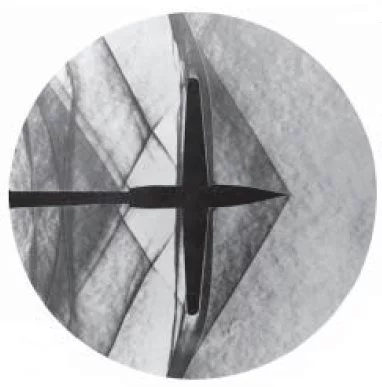NASA has released a new image providing photographic evidence of Boom Supersonic's XB-1 prototype aircraft breaking the sound barrier. Captured on the second supersonic flight, it used a special imaging technique to record the historic event.
A frustrating aspect of many technological achievements is that you often have to take someone else's word that it happened at all. Did Sir Edmund Hillary and Tensing Norgay reach the summit of Mount Everest in 1953? They said they did. Did Jacques Piccard really visit the bottom of the Mariana trench in 1960? So we were told. Did Neil Armstrong and Buzz Aldrin set foot on the Moon in 1969? Oh, don't open that can of worms.
That's not to say none of these happened. Scepticism is all well and good, but it can go a bit too far. Pretty soon, you end up with the old joke that in order to fake the Moon landing you still had to build and launch the giant rocket, so the only money the alleged fraud saved was the catering bill.
We nailed it.
— Boom Supersonic (@boomaero) March 3, 2025
During XB-1’s second supersonic flight, we partnered with @NASA to take this Schlieren image of XB-1 pushing through the air at supersonic speeds. Here’s the shot, captured by NASA teams on the ground. It documents the changing air density around XB-1 and the… pic.twitter.com/89HFHQ30W3
Still, it is nice to have direct evidence of something being pulled off instead of just reels of telemetry data. In the case of Boom achieving the first commercial supersonic flights, the company teamed up with NASA to capture images of the aircraft blasting past Mach 1 using a technique called Schlieren optics.
First invented in 1864, you may have seen examples of this technique in school science textbooks to show bullets in flight or the turbulence from the air rising from a candle flame. However, it's more than a way of making cool pictures to entertain bored students waiting for the bell to ring. It also provides scientists and engineers with valuable information.
There are any number of ways to achieve Schlieren images, but its basics boil down to using a set of special lights, lenses, optical knife edges, and other bits and bobs to light an image, which is reflected onto a screen or through a camera lens to create a very stable image.
The clever bit is that this image remains stable until the air around it is disturbed, like by lighting a candle or having an object flying by at supersonic speeds. This produces subtle changes in air pressure, temperature, density, and other factors. The Schlieren image can detect and make these visible because such changes change the air's refractive index and deflects light. In this way, we can see the heat rising off a human arm, the turbulence of a gun discharge, or the air being pushed by a butterfly's wings.
It's all very dramatic and makes for some great science documentary footage. However, until recently, it was also confined to the lab bench because of the complicated set up required to create things like the culminated light beam and the necessary background.
Then around 2000, DLR Göttingen developed a variant called Background Oriented Schlieren (BOS) that uses a natural textured background and digital imaging to produce Schlieren images without the need for special lighting or complex optical bench set ups.
It achieves this by using a stable background like the desert floor that can be divided into a speckle pattern. This is recorded as a reference image and then when an aircraft like the XB-1 flies through the area the displaced air disturbs the pattern, which can be measured and turned into an image by way of painfully complicated cross-correlation algorithms.
The result: XB-1 going supersonic caught on film, or the 21st century equivalent. That may be a nice snap for the history books, but BOS has practical applications. By studying the images, engineers can confirm and enhance the sonic-boom-deadening properties for the XB-1's airframe. It can also be used to look at helicopter rotors or propeller blades, analyze vortex patterns on wings, and record how aircraft flying in formation disturb one another by mixing air streams.
And maybe give future students more cool pictures to look at.
Source: Boom Aerospace








